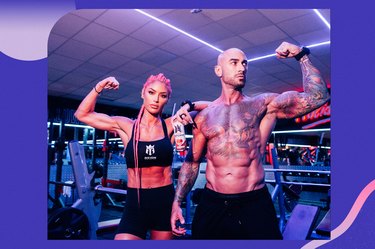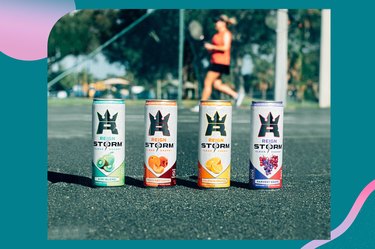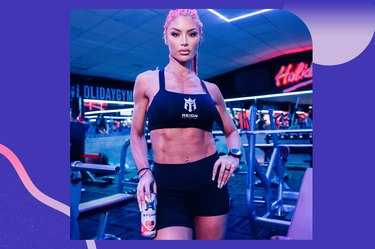
We live in an age when misinformation is a part of our daily lives. Whether you read a social media post touting a "life-changing" new workout or see a billboard for a "miracle" weight-loss supplement, it can become hard to distinguish fact from fiction.
Fitness trainers, Reign Total Body Fuel athletes, and husband and wife duo Natalie Eva Marie and Jonathan Coyle know this all too well — over the course of their fitness journeys, they tried every fad diet and trending workout.
Video of the Day
Video of the Day
"We've done it all," says Coyle, who is a master trainer with the International Sports Sciences Association (ISSA). "But what doesn't get talked about a lot is everybody's body is different."
As they've charted their path through the fitness world, Marie and Coyle have learned much the hard way — and now their goal is to help others avoid the trial-and-error process by debunking some of the most common myths.
Myth 1: Exercise Is More Important Than Nutrition

Nutrition is equally as important as exercise for supporting your overall health, and your diet plays a key role in helping you hit your goals in the gym, too. Skimping on nutrition can compromise your workout performance and cause fatigue, according to the Mayo Clinic.
"Your nutrition has to be dialed in, and it has to complement what you're doing in the gym or else it just doesn't work," says Marie, who is a former WWE wrestler and lead trainer and founder of NEM FIT. "You're not going to see the results, and you have to take into consideration what is happening inside your body."
For example, if building muscle is your goal, you'll want to focus on getting enough protein each day. Whereas if your goal is to build endurance, you'll need to ensure your body is fueled up with carbs.
Another nutrition tip Coyle and Marie recommend is switching out your caffeinated sodas, syrupy coffee or sugary energy drinks for a Reign Storm. The sugar-free drink is packed with vitamins A, B, C and zinc, and it tastes delicious. Plus, it contains 200 milligrams of plant-based caffeine along with green tea extract, panax ginseng and guarana, all of which are known for their naturally energy-boosting properties.
Consuming caffeine before a workout has been linked to enhanced physical performance and cognitive function, according to a 2018 Nutrients review. So next time you head to the gym, leave some room in your gym bag for a Reign Storm to help you make the most out of your workout.
Myth 2: If It Works for Them, It'll Work for Me

Have you ever tried a workout program after hearing about someone else's results, only for it to not yield the same results for you? Lots of people have (the entire fitness influencer industry is built around it, after all), which is why Coyle emphasizes the importance of finding what works best for you when it comes to diet and exercise.
Case in point: Coyle and Marie work out very differently. While Marie opts for a quick 30 to 45 minutes of high-intensity interval training, Coyle takes his weight training slow and does low-intensity cardio so he can check his emails while he exercises, which means he's usually at the gym for over two hours. But that doesn't mean one of their workouts is more effective than the other — it's just what works for their bodies and lifestyles.
In fact, a small June 2020 study in the Journal of Physiology that followed 42 pairs of healthy twins found people's physiques reacted differently to the same exercise and that the right exercise program differs from person to person. So don't sweat it if your results don't match those of that TikTok influencer you admire — whatever workout they're praising might not be the right approach for your body.
Myth 3: Skipping Recovery Isn't That Bad

After a sweaty workout, all you want to do is relax — but skipping your post-workout recovery isn't a good idea. Giving your body time to recuperate after you work out is essential to preventing injuries and allowing your muscles to rebuild themselves, according to the American College of Sports Medicine (ACSM).
"One of my biggest regrets is that when I was younger I didn't take my recovery after working out as seriously, like I would never want to stretch," Marie says. "I always thought, 'Why? It's boring and it's not going to do anything for you.' But it's been proven now that your recovery is essential for longevity."
Not sure what effective recovery looks like? Stretching is always a good place to start, and the ACSM also recommends foam rolling, massage therapy, hydration, compression and one of Marie and Coyle's favorites: cold therapy (they swear by cold plunges). If you're feeling too drained to do a full recovery routine, Marie and Coyle suggest cracking open a Reign Storm for an energy boost. Your muscles will thank you for the extra TLC.
- Mayo Clinic: "Nutrition rules that will fuel your workout"
- The Journal of Physiology: "Fitness and strength responses to distinct exercise modes in twins"
- ACSM: "A Road Map to Effective Muscle Recovery"
- Nutrients: "The Influence of Caffeine Expectancies on Sport, Exercise, and Cognitive Performance"